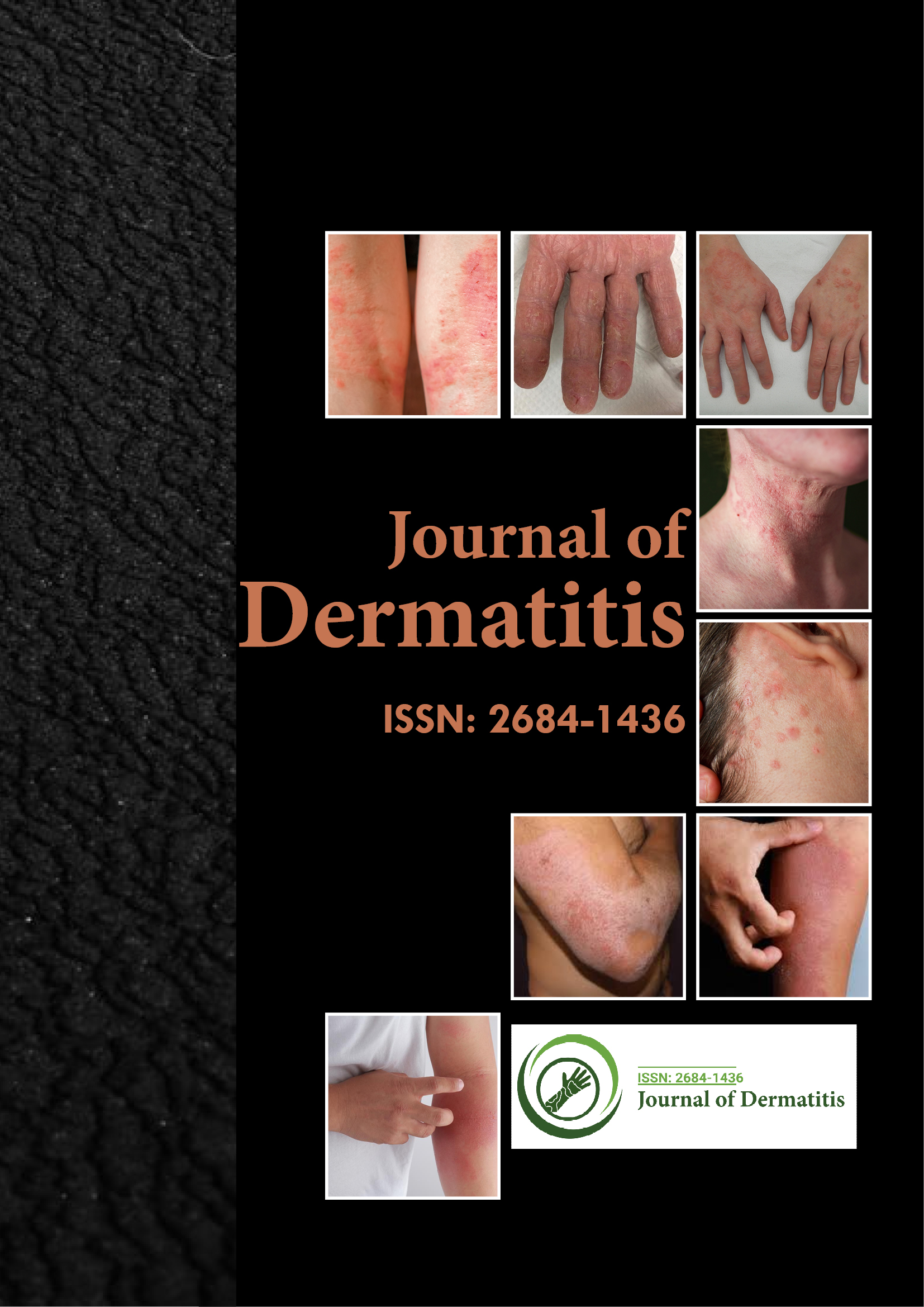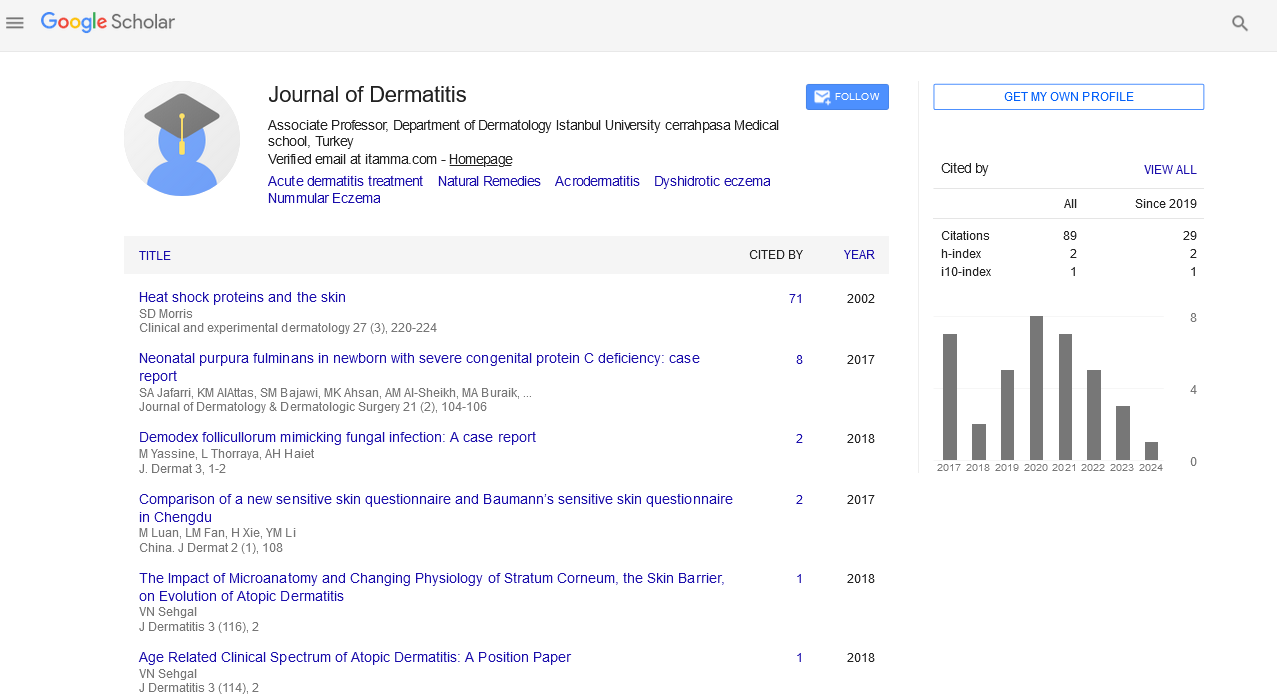Indexed In
- RefSeek
- Hamdard University
- EBSCO A-Z
- Euro Pub
- Google Scholar
Useful Links
Share This Page
Journal Flyer

Open Access Journals
- Agri and Aquaculture
- Biochemistry
- Bioinformatics & Systems Biology
- Business & Management
- Chemistry
- Clinical Sciences
- Engineering
- Food & Nutrition
- General Science
- Genetics & Molecular Biology
- Immunology & Microbiology
- Medical Sciences
- Neuroscience & Psychology
- Nursing & Health Care
- Pharmaceutical Sciences
Perspective - (2024) Volume 9, Issue 3
Molecular Mechanisms of Allergic and Irritant Contact Dermatitis Revealed by Single-Cell RNA Sequencing
Ali Rahman*Received: 30-Aug-2024, Manuscript No. JOD-24-27948; Editor assigned: 02-Sep-2024, Pre QC No. JOD-24-27948 (PQ); Reviewed: 16-Sep-2024, QC No. JOD-24-27948; Revised: 23-Sep-2024, Manuscript No. JOD-24-27948 (R); Published: 30-Sep-2024, DOI: 10.35248/2684-1436.24.9.245
Description
The skin is a critical organ for immune defense, serving as a defense against environmental insults, including allergens and irritants. Contact Dermatitis (CD), an inflammatory skin condition, arises from the exposure to these harmful substances. Broadly, CD is classified into two major categories: Allergic Contact Dermatitis (ACD) and Irritant Contact Dermatitis (ICD). While these two forms of dermatitis share overlapping clinical features, they have different immunological mechanisms. Recent advances in single-cell RNA sequencing (scRNA-seq) are providing novel insights into the molecular differences between ACD and ICD, allowing for the identification of precise biomarkers and pathways that distinguish these conditions at a cellular level.
ACD and ICD are both characterized by skin inflammation, but the fundamental causes and immune responses differ significantly. ACD is an immune-mediated condition driven by a hypersensitive reaction to specific allergens, typically involving the activation of T cells. ICD is a non-immunological response to direct damage or irritation of the skin, often initiated by substances like soaps, solvents, or physical abrasions. Although both conditions present with erythema, swelling and itching, understanding their different molecular and cellular features is important for improving diagnosis and treatment strategies.
Single-cell RNA sequencing has become as a powerful tool in understanding the heterogeneity of immune responses at the level of individual cells. By allowing the examination of gene expression profiles in individual cells, scRNA-seq provides a high-resolution view of how specific cell types respond to environmental insults, both in the context of ACD and ICD. This technology has the potential to uncover previously unknown molecular signatures that differentiate these two forms of dermatitis, providing insights that could lead to more targeted and effective therapies.
Recent studies utilizing scRNA-seq have revealed different gene expression patterns in the skin of patients with ACD and ICD. One of the most important findings is the differential activation of immune cell populations, particularly dendritic cells, T cells and keratinocytes, in response to allergen exposure vs. irritant insult. In ACD, allergen-induced activation of Langerhans cells and other dendritic cells leads to the release of pro-inflammatory cytokines, such as IL-1β, IL-6 and TNF-α, which in turn recruit T-helper cells to the site of inflammation. These T cells, specifically Th1 and Th17 subsets, contribute to the chronicity and severity of the allergic response. In contrast, ICD is characterized by an influx of neutrophils and macrophages, which respond to the direct cytotoxic effects of irritants rather than to an antigen-specific immune response. The scRNA-seq data highlight these differences in immune cell composition, with ACD showing a stronger Th1/Th17-driven response and ICD displaying a more significant neutrophilic response.
One important finding from scRNA-seq studies is the identification of specific molecular signatures in keratinocytes that distinguish ACD from ICD. In ACD, keratinocytes exhibit upregulated expression of genes involved in antigen presentation and cytokine production, such as MHC class II and IL-6. This suggests that keratinocytes play an active role in the immune response in ACD, likely participating in the recruitment and activation of T cells. Alternatively, keratinocytes in ICD are more likely to exhibit stress-related gene expression, such as those involved in oxidative stress and apoptosis, which aligns with the non-immunological damage caused by irritants. These findings suggest that keratinocytes in ACD may act as active participants in the immune response, whereas in ICD, they primarily respond to physical damage and inflammation caused by irritants.
In conclusion, single-cell RNA sequencing is an important factor for decoding the molecular mechanisms that differentiate allergic from irritant contact dermatitis. By providing a highresolution view of gene expression in individual cells, scRNA-seq has revealed different immune signatures that carry the pathogenesis of these two forms of dermatitis. The insights gained from these studies have the potential to improve diagnostic accuracy, enable the development of more targeted therapies and deepen our understanding of how the immune system responds to environmental insults. As scRNA-seq technology continues to evolve, it is likely that new molecular pathways and biomarkers will be discovered, further enhancing our ability to treat and manage contact dermatitis.
Citation: Rahman A (2024). Molecular Mechanisms of Allergic and Irritant Contact Dermatitis Revealed by Single-Cell RNA Sequencing. J Dermatitis. 9:245.
Copyright: © 2024 Rahman A. This is an open access article distributed under the terms of the Creative Commons Attribution License, which permits unrestricted use, distribution, and reproduction in any medium, provided the original author and source are credited.

